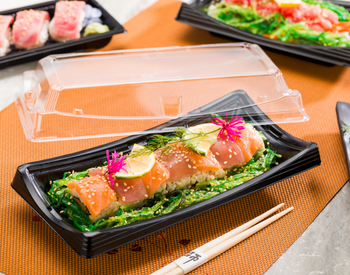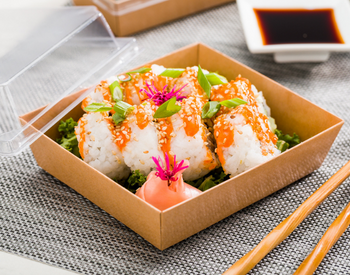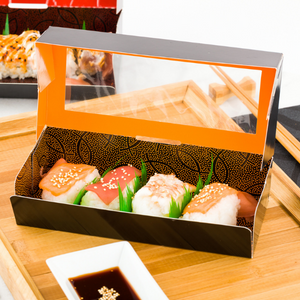As take out and delivery services continue to gain popularity, establishments should consider adopting new and efficient packaging methods to enhance customers' dining experience. Sushi restaurants are no exception. On the contrary, since sushi bars handle raw seafood, they are the prime example for improved methods of safely and innovatively packaging to go meals. In this buying guide, we break down each type of sushi container so you can find the right containers to swimmingly pack up carry out orders.
How To Pack & Store Sushi
When packaging rolls for take out and delivery services, it's essential to properly package sushi rolls to help them stay fresher for longer. Using sushi containers with lids that create an airtight seal keeps rolls from drying out. If patrons request spicy mayo, eel sauce, soy sauce, and other condiments with their orders, package them in portion cups to eliminate messes and prevent rolls from getting soggy. Here are a few tips on how to properly package sushi rolls so you can preserve their quality:
- Tightly pack sushi together and wrap in plastic wrap and place in an airtight container.
- Cover sushi in a damp paper towel, wrap it in plastic, and store in an airtight container.
- Soak a paper towel with a mixture of a tablespoon of rice vinegar or lemon juice and a teaspoon of soy sauce, wrap the sushi in the soaked paper towel, and place in an airtight container.
Note: Regardless of which method you choose to save those leftover rolls, try to consume within 24 hours of storing.
How To Reheat Sushi Rolls
Leftover sushi stored in the fridge tends to get cold and loses some of its texture and flavor. Reheating sushi sounds like an uncommon thing to do, but there are a couple of ways to repair that stale sushi rice:
Microwave: 30 seconds at 500 Watts - will slightly cook raw fish while returning sushi rice and nori to room temperature without becoming soggy.
Bake: 4 minutes on each side at 325°F - will cook raw seafood, restore crunchiness to tempura, and add crispiness to sushi rice.
Sushi Container Materials
Each sushi take out container has various aspects such as durability, sustainability, and price. Understanding the benefits of each kind of container will help you find the one that best fits your establishment’s needs. Below is a breakdown of the different sushi container materials to most effectively pack on-the-go rolls.
Foam Sushi Containers
 Foam sushi containers tend to be the inexpensive option out of all other materials. While foam products are not microwave-safe or freezer-safe, they are good insulators for cold or warm foods. These containers are also not eco-friendly, which doesn’t make them ideal for eco-conscious establishments.
Foam sushi containers tend to be the inexpensive option out of all other materials. While foam products are not microwave-safe or freezer-safe, they are good insulators for cold or warm foods. These containers are also not eco-friendly, which doesn’t make them ideal for eco-conscious establishments.
Plastic Sushi Containers
 Plastic sushi containers are the most commonly used within foodservice establishments. Most plastic containers are recyclable, allowing for a greener packaging choice than foam containers. This type of take out sushi container usually includes a lid that creates a tight seal to keep foods safe. The lids of these containers also tend to be transparent to present a clear view of packaged meals. Take a closer look at our line of Roku plastic sushi containers to learn more about their benefits:
Plastic sushi containers are the most commonly used within foodservice establishments. Most plastic containers are recyclable, allowing for a greener packaging choice than foam containers. This type of take out sushi container usually includes a lid that creates a tight seal to keep foods safe. The lids of these containers also tend to be transparent to present a clear view of packaged meals. Take a closer look at our line of Roku plastic sushi containers to learn more about their benefits:
Paper Sushi Containers
 Paper sushi containers are the most environmentally conscious alternative as they are either recyclable or compostable. Paper containers tightly seal in meals with compatible lids which are usually clear to showcase sushi rolls. These kinds of containers are available in various finishes to customize your food packaging aesthetic. Here are some details on our line of Matsuri Vision paper sushi containers:
Paper sushi containers are the most environmentally conscious alternative as they are either recyclable or compostable. Paper containers tightly seal in meals with compatible lids which are usually clear to showcase sushi rolls. These kinds of containers are available in various finishes to customize your food packaging aesthetic. Here are some details on our line of Matsuri Vision paper sushi containers:
Sushi Container Styles
Particular sushi container shapes and designs allow you to effortlessly package sashimi or nigiri. With every shape and design serving a unique purpose, it's vital to understand which containers are best for your menu items.
Shapes
- Square: These containers work best for individual pieces of sushi, especially those that can be packed flat like sashimi, nigiri, or simpler sushi rolls such as California or veggie rolls.
-
Rectangle: These containers allow for efficiently fitting whole sushi rolls vertically without having to split or sacrifice specialty sushi’s presentation.

Design
- Curved edge: A unique and elegant aesthetic to delivery orders. Elevates the packed sushi rolls for a clearer view and keeps sauces or toppings from spilling over.
- Straight edge: A timeless and traditional look for packaged orders. Presents a neutral surface to highlight the contents inside the container.
- Windowed: A one-of-a-kind design that eliminates the need for a separate container lid. Provides a sneak peek at the packaged food.
Alternative Uses For Sushi Containers
Although included in the name, sushi containers aren’t strictly limited to just Asian cuisine. Because of the versatile build of the containers, many people use them to pack other snacks and mini plates such as:
- Salads
- Pastries
- Charcuterie
- Finger sandwiches
Which Sushi Container Is Right For You?
Deciding on the right type of sushi container to package your seafood creations is dependant on the material, shape, design, and size. If your establishment prioritizes eco-consciousness, it’s important to keep the more eco-friendly options in mind to stay on brand or just lend a helping hand to the environment. The most beneficial container encompasses all of your preferences and manages to help the delivery service process as well as improve customers’ experiences.






